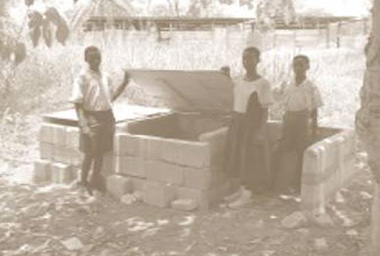Resource 3: Making compost
![]() Background information / subject knowledge for teacher
Background information / subject knowledge for teacher
The best and cheapest way to make garden soil better is to make your own compost. It only costs effort and a little bit of time and care.
Choose an out-of-the-way part of the school garden that is quite sunny. Clear away any weeds and rubbish.
When you have an open space, one of the pupils can mark out a circle with a radius of about 75 cm. If this pupil stands in the centre of the circle and turns around while holding out a walking stick, a good circle will have been drawn.
Take spades and dig up the soil in the circle. Dig to the depth of the blade of the spade. Use a garden fork to make the soil in the circle loose.
Make a small pile of spare soil next to your circle by moving about a third of your loosened soil from the circle.
Stick a central pole or straight branch into the soil in the centre of the circle.
Now you can start the compost-making process. Put a layer of twigs and old leaves you have collected on top of the loose soil. The more you have the better.
Next, put down a layer of stalks and stems from plants and any kitchen waste (potato peelings, old tea bags or tea leaves, eggshells). You can even add shredded scraps of paper.
Then add a dry layer of grass cuttings, dry grass or old dry leaves.
Finish by putting a thin layer of soil on top. Use the loosened soil from the pile next to your compost heap.
Go on adding more layers:
- first stalks, stems, twigs and leaves;
- then kitchen waste and green cuttings;
- then dry grass, old leaves and manure (if you can find it);
- finish each layer with a last layer of soil.
Sprinkle a little water – but don’t make the compost heap too wet.
The height will drop as the matter rots down. Then you can add more layers over time. Always keep a layer of soil on the top – this deters the flies.
Container composting in peri-urban Kumasi, Ghana
Using compost containers allows the safe and hygienic composting of domestic organic waste to take place in urban and peri-urban backyards. In addition to producing natural fertiliser for urban and peri-urban agriculture (UPA), backyard composting reduces the amount of domestic organic waste destined for open refuse dumps or municipal landfill sites, thus contributing to a cleaner environment and, where waste collection services are provided, a reduction in collection and transport costs (GFA-Umwelt, 1999).
Compost containers can be made from recycled materials such as tyres, blocks, bricks, wood, plastic barrels or 250-litre drums; thereby making the technology accessible for low income groups. When the technology is implemented appropriately, it can not only improve environmental sanitation but also enhance local livelihoods.

Resource 2: Products from crude oil



